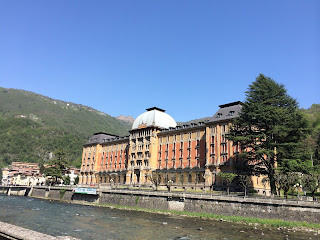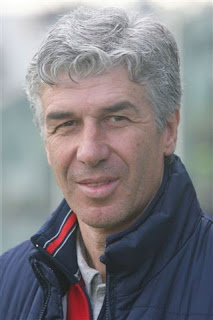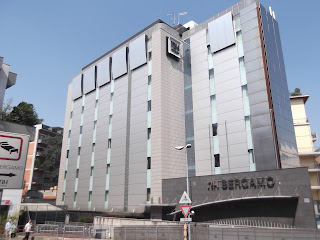Natale adds extra sparkle to Lombardy’s hidden gem
The beautiful city of Bergamo has now become even more magical, adorned with thousands of twinkling lights, colourfully decorated Christmas trees and lovingly recreated nativity scenes, known in Italian as presepi.
 |
| Christmas tree lights up a corner of Piazza Vecchia |
On Christmas Eve, la Vigilia di Natale, it was warm and sunny with a clear blue sky while people completed their Christmas shopping, with most of the shops open for business, even though it was a Sunday.
Hundreds of people dressed as Santa Claus - Babbo Natale to Italians - competed in a fun run for charity, Babbo Running, handily finishing on Via Sentierone in the Città Bassa, so they could go into the bars still in costume for a refreshing drink afterwards, adding to the festive atmosphere.
The night before Christmas, the buses and the funicular railway were running until late, making it possible to go up to the Città Alta to dine out.
Restaurants were open on both Christmas Eve and on Christmas Day, Natale, but were all filled to capacity, so it is well worth booking in advance, by either email or telephone, to make sure you get a table at your favourite.
There were Christmas concerts in many of the churches and more informal festive entertainment put on in some of the bars.
 |
| The talented Maysingers perform in the Tucans Pub in Via Donizetti |
Some shops and bars were open on Christmas Day in the morning but there was no public transport running. Thankfully the day dawned bright and clear, with warm sunshine, making the walk up to the Città Alta enjoyable.
Many shops and businesses in the city had followed the custom of leaving a seat outside for Santa, adding to the festive atmosphere.
The shops were all filled with seasonal goodies, such as the traditional Panettone and Pan d’Oro and also torrone, a type of nougat made in Cremona, which is a traditional gift to take when visiting friends on Christmas morning. Negozio Sperlari in Via Solferino, in nearby Cremona, has become famous for making torrone. The concoction of almonds, honey and egg whites was created in the city to mark the marriage of Bianca Maria Visconti to Francesco Sforza in 1441, when Cremona was given to the bride as part of her dowry.
In one supermarket in Bergamo’s Città Bassa, a special offer enabled customers to buy a bottle of Aperol, a bottle of Prosecco and a very large bag of crisps, patatine, for just 10 euros,the makings of a very merry Christmas!
 |
| Supermarket special offer |
Editor’s note: ‘Particular praise should go to the restaurant Il Sole in Via Colleoni just off Piazza Vecchia in the Città Alta. The restaurant was full for Christmas lunch and offered a very good à la carte menu. The courses were served promptly and all the dishes we ordered were hot and delicious. The staff were cheerful and attentive. It was a lovely convivial atmosphere and I would recommend the restaurant to anyone wishing to enjoy a good Christmas lunch in Bergamo’s Città Alta next year.’
For more information visit www.ilsolebergamo.com
For more information visit www.ilsolebergamo.com
Buon Natale e Buon Anno from Best of Bergamo !















